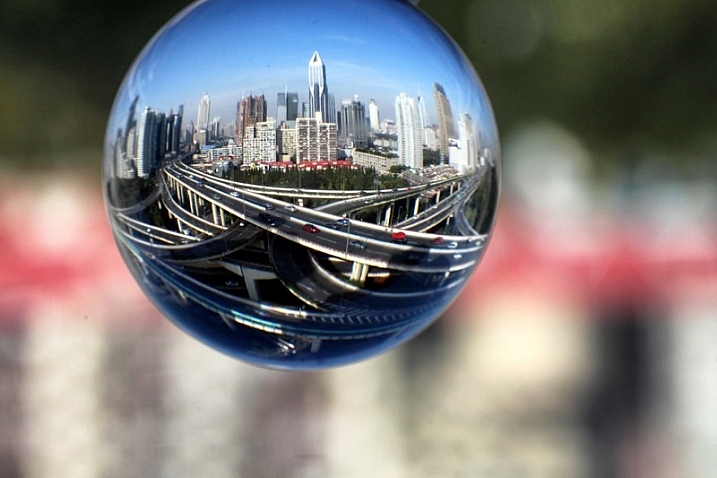The application of science to photography is a great way of getting creative results with your work. The camera itself is, of course, a product of scientific endeavor. One that brings everyone here to learn more about it. Inside the camera are a series of optics that use refraction to render the image onto your camera sensor, though refraction can be used even more creatively in photography.
googletag.cmd.push(function() {
mobile_slots.push( googletag.defineSlot( “/1005424/_dPSv5topic-rhs(300×250)”, [300, 250], “pb-ad-124309” ).addService( googletag.pubads() ) ); } );
To take refraction photographs you will need to find an object that produces this effect, such as a glass ball. The effect happens when light passes through an object of denser mass, and the light is bent as it goes through.

Flags such as the Union Jack make great subjects for refraction.
Objects that cause refraction
Any transparent object that has a different mass to air will cause refraction. The most useful objects that refract are those which are spherical. While it’s possible to get refraction through transparent plastic objects, for the best image quality you’ll want to be shooting through glass.
As you can read in my previous article: 7 Tips for Doing Crystal Ball Refraction Photography, glass balls are a favorite for this type of effect, though not everyone has one on hand. There are other objects that you can use for refraction such as; wine glasses, marbles, and water drops.

This photo was taken through the bottom of a drinking glass. The bobbles at the bottom refracted the light.
1 – Refraction using a glass ball
The glass ball is probably the most popular item used in refraction and is what you immediately think of if someone says refraction photography. This is a great piece of extra kit to have in your camera bag and can do wonders for creating a unique looking landscape photo.
The ball can also be good for architecture and even portrait photos if you now how to use it properly. You need to think of the ball as an external fish-eye lens. The ball then needs to be carefully placed on a wall, so it’s elevated to the same level as the object you’re shooting.

The ferris wheel is refracted inside this glass ball, the bokeh shapes compliment the scene well.
2 – Marbles are small glass balls, great for refraction!
A smaller alternative to a glass ball is the marble. Photographing a marble is in many ways the same as photographing its larger counterpart. The key difference is that it’s much smaller, and using a macro lens becomes important. There are a few key points you need to consider when photographing a marble versus a glass ball.
- The glass may not be as good quality, leading to a poorer image inside the marble.
- There will be more distortion and a smaller sweet spot where the image is clear.
- The weight is significantly less making them much easier to carry around.
- The small size often makes them easier to place on a surface without falling off, they sit in smaller divots.
- You will need a lens capable of macro photography to best photograph with marbles.

The much smaller size of a marble enables you to place it in otherwise inaccessible locations.

3 – Make a splash with water droplets
A glass ball is not the only medium you can use to create refraction, water makes a great alternative. The key to using water in this way is photographing it as a droplet. There are a few ways to do this, you could try all of them!
- Water droplet photography – If you’ve never tried this type of photography before I highly recommend it, it’s a lot of fun. Introducing a background image such as a flag will lead to that object being refracted inside the water drop!
- Tap droplet photography – This is almost identical to the first example, this time you capture the droplet mid-flight. Once again you will want to have a background image behind the water drop. Follow the steps recommended in the water droplet article, and replace the water bag with a tap and voila. Here are some great examples of this type of photo.

These water droplets were placed on glass using a syringe, with the flag of Malaysia is behind them.
- Naturally occurring water drops – Water drops on spider webs, or on flower petals are spherical, and will therefore refract. So get out there after it’s rained, or if you’re not patient there is always the not so natural watering can or syringe to create your own.
- CDs and water drops – Placing water drops onto a CD using a syringe will create a great effect. Think of all those mini rainbows! To take this type of image you will need to place water droplets on a CD. Then compose your image, and turn the lights off. Finally, move a flashlight around the CD during a long exposure, doing light painting.
- Water droplets on glass – This is similar to placing water drops on a CD, but you will use a strobe to light up the scene. Place your water drops onto a glass pane, with your image in the background below it.

The drop of water from a tap is caught mid-flight.
4 – Make that wine glass multi-task!
The real reason wine glasses are round is because they can be used for refraction photography! Okay, they are for wine, but that doesn’t mean photographers can’t use them as well.
The spherical nature of this type of glass means filling them with water will allow you to see a refracted image inside the glass. The wine glass is, of course, better than the glass ball for placing on a flat surface, as it’s not going to roll off. You can use a wine glass in portrait photos as well. In that scenario, the wine glass acts as a great prop, which also shows the refracted image in the background.

This wine glass filled with water shows the effect of refraction.
Get out and give refraction a try
There are multiple ways you can go about starting a series of refraction photos, and this type of photography makes a very interesting project. Let’s see your work if you have taken these types of photos before.
Are there any other refraction type photos you can recommend? Those who have never tried this technique before, give it a go! The community looks forward to seeing your photos, and it could become your project for the year!

The light is refracted through these water droplets when placed on a CD.
googletag.cmd.push(function() {
tablet_slots.push( googletag.defineSlot( “/1005424/_dPSv4_tab-all-article-bottom_(300×250)”, [300, 250], “pb-ad-78623” ).addService( googletag.pubads() ) ); } );
googletag.cmd.push(function() {
mobile_slots.push( googletag.defineSlot( “/1005424/_dPSv4_mob-all-article-bottom_(300×250)”, [300, 250], “pb-ad-78158” ).addService( googletag.pubads() ) ); } );
The post 4 Refraction Ideas to Use Your Creativity by Simon Bond appeared first on Digital Photography School.









You must be logged in to post a comment.